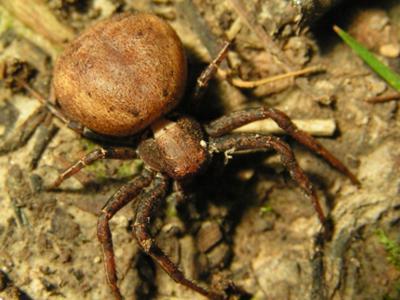Xysticus luctator
Taxonavigation:
Regnum | Animalia |
Phylum | Arthropoda |
Subphylum | Chelicerata |
Classis | Arachnida |
Ordo | Spiders (Araneae) |
Familia | Crab spiders (Thomisidae) |
Genus | Xysticus |
Species | Xysticus luctator |
Biology and behavior:
Body length: females up to 7 to 10 mm, males up to 6 to 7 mm. They are called crab spiders because they resemble crabs, with two front pairs of legs angled outward and bodies that are flattened and often angular. Also, like crabs, Thomisidae can move sideways or backward. Red-brown color. Prosoma with dark brown sides and dyed yellow to orange-brown middle band, which can be very indistinct. Head triangular shaped eye absent or only very subtly. Opisthosoma with dark brown top, which more or less sharp Duch bright side is limited. Top hardly figured. In the male groups of bright stripes are visible. Legs yellow to orange-brown. The front legs are mottled dark brown and dark proximally. Hind legs lighter with dark spots. The Epigyne consists of a large, more or less transverse-oval pit.
Xysticus luctator range:
This rare race primarily spread in Central Europe and Eastern Europe but individuals were found in Asia.
Diet:
Crab spiders do not build webs to trap prey, but are hunters and ambushers. Members of the genus Xysticus hunt in the leaf litter on the ground. In each case, crab spiders use their powerful front legs to grab and hold onto prey while paralyzing it with a venomous bite.
Reproduction:
Spiders reproduce sexually and fertilization is internal but indirect, in other words the sperm is not inserted into the female's body by the male's genitals but by an intermediate stage. Unlike many land-living arthropods, male spiders do not produce ready-made spermatophores (packages of sperm) but spin small sperm webs on to which they ejaculate and then transfer the sperm to syringe-like structures on the tips of their pedipalps. When a male detects signs of a female nearby he checks whether she is of the same species and whether she is ready to mate; for example in species that produce webs or "safety ropes", the male can identify the species and sex of these objects by "smell".
